OVERVIEW
Many firms across the globe are deepening their focus on pay equity. Driven by a combination of regulatory pressure and good intentions, firms are beginning a closer look at a problem that has existed for a long time. However, organizations seeking to create more equitable workplaces need to broaden the scope and solve for career equity.
The United States passed federal regulation in 1963 which prohibited discriminatory pay practices on the basis of sex:
(1) No employer having employees subject to any provisions of this section shall discriminate, within any establishment in which such employees are employed, between employees on the basis of sex by paying wages to employees in such establishment at a rate less than the rate at which he pays wages to employees of the opposite sex in such establishment for equal work on jobs the performance of which requires equal skill, effort, and responsibility, and which are performed under similar working conditions, except where such payment is made pursuant to (i) a seniority system; (ii) a merit system; (iii) a system which measures earnings by quantity or quality of production; or (iv) a differential based on any other factor other than sex: Provided, That an employer who is paying a wage rate differential in violation of this subsection shall not, in order to comply with the provisions of this subsection, reduce the wage rate of any employee.
Interestingly, the drafters of this regulation had the foresight to specify that pay differences may indeed exist based on seniority, performance, or other fact-based variances. Just as significant, perhaps, is the fact that this legislation does not prominently reference any other basis beyond sex as a concern, or specify the need for equality in how employees achieve seniority or performance assessment or other factors that ultimately drive pay. Thus pay equity must be examined to include other diversity dimensions such as race, religion, sexual orientation and the process in which employees are able achieve Career Equity. We argue that Career Equity is facilitated by Job Architecture. Job architecture is a comprehensive structure that organizes jobs into a logical hierarchy, including position descriptions, title criteria and equitable performance goals.
To be clear, pay equity is absolutely critical, and is not something to be deferred or phased in over some period of time. There have been a set of systemic inequities across the career spectrum that have caused this problem, but you cannot solve pay equity without attending to career equity. The Career Equity System includes five components: hiring, assessment, representation, advancement, any pay.
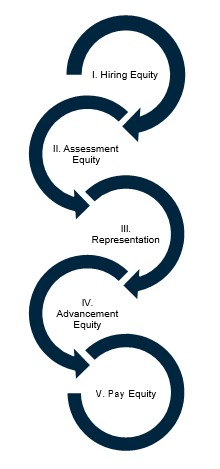
CAREER EQUITY SYSTEM
We envision a sequential framework of practices and policies that will culminate in pay equity, by providing and equitable career opportunity that spans a candidate’s journey from applying for a role all the way through achieving a senior, well-rewarded position at a firm. Firms that are committed to career equity will often find job architecture a critical tool in achieving these five components.
I. HIRING EQUITY
Real pay equity hinges on equitable hiring, across the spectrum of sourcing a diverse slate of candidates, having diverse interview panels, having objective selection criteria and more. Position Descriptions are a critical component in Job Architecture, and the ability to indicate objectively the expectations of a role not only sets a consistent standard for what we expect in terms of hiring, but also lays the groundwork for what we expect once the candidate joins. A shared understanding of what is expected from an employee, beginning with a Position Description and transitioning into Role Objectives as part of the performance management process helps pave the way for Career Equity. This way two employees in the same role with a consistent position and equitable goals in the performance management system creates a reasonable and fair starting point.
II. ASSESSMENT EQUITY
A topic that gets overlooked in the pay equity discussion is the objectiveness of performance assessment. How do we have equitable pay and equitable promotions with a flawed performance assessment mechanism?
Firms have largely relied on employees setting their own goals, with some management review. Not surprisingly, this bespoke approach to defining expected contributions leads to employees in the same role having different goals, goals of varying difficulty, and in many cases, simply no goals set at all.
Managers who assess performance at year-end based on inequitable goals have very little ability to adjust for this and give final performance assessments that are objective and consistent. Optimized Job Architecture, where a set
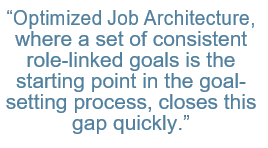
of consistent role-linked goals is the starting point in the goal-setting process, closes this gap quickly. Certainly, each individual in an organization may have some unique responsibilities or initiatives to deliver on, but a well-designed role- based goal library is critical to giving the assessment process even footing.
Further, many firms do not have calibration processes that look at equity across a number of diversity dimensions BEFORE finalizing performance assessments. This review – a control point to calibrate the difference in assessments various employee groups have received – is a critical component of career equity. When you consider how many firms have target bonuses or salary increases that are triggered by performance ratings, waiting until after ratings have been finalized to conduct equity assessments is simply too late
III. REPRESENTATION
Seniority – and how you get there – was referenced in the 1963 United States legislation but is an often under-addressed component of pay equity. Consider the blunt force approach adopted in the United Kingdom in 2017, with good intent, to measure pay equity:
“The gender pay gap is the difference between the average (mean or median) earnings of men and women across a workforce. From 2017, if you are an employer who has a headcount of 250 or more on your ‘snapshot date’ you must comply with regulations on gender pay gap reporting. Gender pay gap calculations are based on employer payroll data drawn from a specific date each year. This specific date is called the ‘snapshot date’.
Calculating and observing the difference between average pay for men and women ignores a very large and seemingly obvious concern: in general, women and other underrepresented groups historically haven’t had the same opportunities to achieve seniority or to move into more lucrative functions. Barriers such as bias and discrimination need to be removed and leadership must be proactive in communicating and demonstrating their commitment to anti-discriminatory policies. These policies should champion inclusion across all diversity demographics and have goals beyond standard compliance.
Representation shows up in survey data as a significant concern for employees. In a recent Meritarc survey (Survey Conducted by Meritarc Finds Employees Desire More Strategic Investment in DEI Initiatives | Meritarc), note the difference in responses from men and women, and white and non-white respondents, when asked to respond to “There are people similar to myself in leadership positions at my organization”:

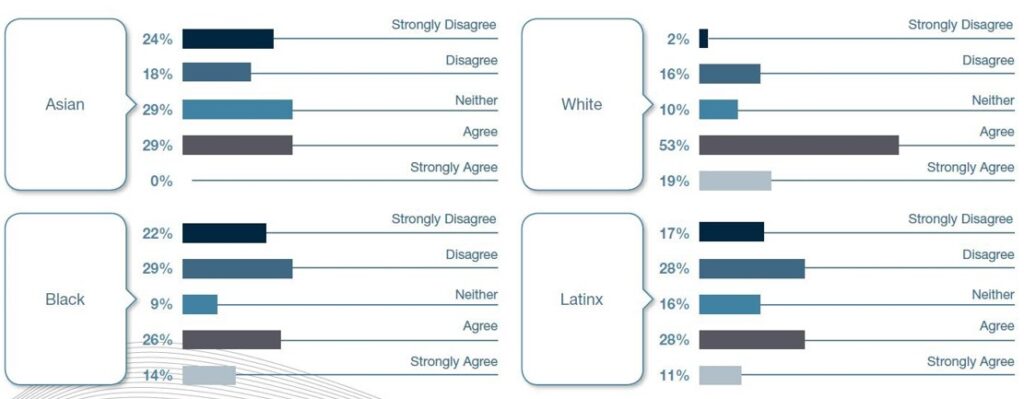
IV. ADVANCEMENT EQUITY
Related to, but different from representation (which includes external hiring, for example) is advancement equity – who gets promoted, and why.
Firms in the market run the gamut from very complex, thorough promotion processes that include documentation, review panels, actual interviews, detailed promotion criteria and more to firms that largely allow each individual manager, with no promotion criteria, to use their judgement or instincts to decide who gets promoted. The latter approach is probably more common than we would like to think.
Pay equity will rely heavily on advancement equity. Even firms with relatively little structure tend to organize pay around seniority, at least to some degree. Employees who do not get promoted have little chance of growing their pay over time in a meaningful way.
A critical component of Job Architecture is promotion criteria. While the presence of promotion criteria does not mitigate the possibility of inequitable promotion decisions, the clearer and more specific promotion criteria is, the better the chance of an objective or at least a MORE objective promotion process there is.
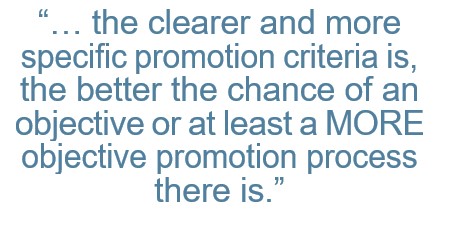
Ideally, promotion criteria should be widely available for employees to see, and annual goal-setting processes should include a review of promotion criteria, and a discussion around how to best gain the skills and competencies and accountabilities to be eligible for promotion. Firms that build this sort of career planning into goal-setting as a matter of course are doing a great service to themselves, as well as the overall cause of Career Equity.
V. PAY EQUITY
Once we have equitable hiring practices, clear and objective feedback and assessments, representation, and consistent promotion processes, we have the foundation in place for equitable pay.
Increasingly, both domestically and globally, there is a movement to have greater transparency around salaries, including legislation banning employers from asking candidates to disclose salary history. This legislation is spreading in the United States, and one of the positives of this is that it should help reduce salary equity issues beyond gender-driven difference.
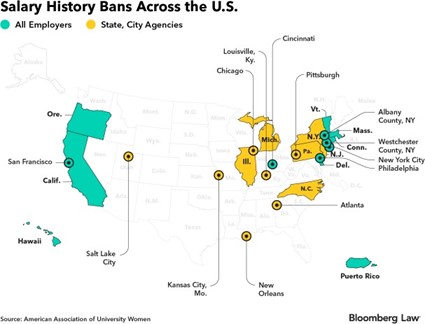
As firms prepare for this greater level of transparency, we see an increased focus on more formalized and systematic salary administration. Towards this end, many firms are either implementing salary banding or reviewing existing salary banding approaches to better position recruitment and hiring managers to make consistent offers. Salary administration systems are under increased pressure to ensure internal equity (parity for new hires vs. existing employees), and to account for inflation and career trajectory as well. A well-designed salary banding system balances precision (competitive market positioning) with administrative simplicity (grouping like-paid jobs into consolidated structures).
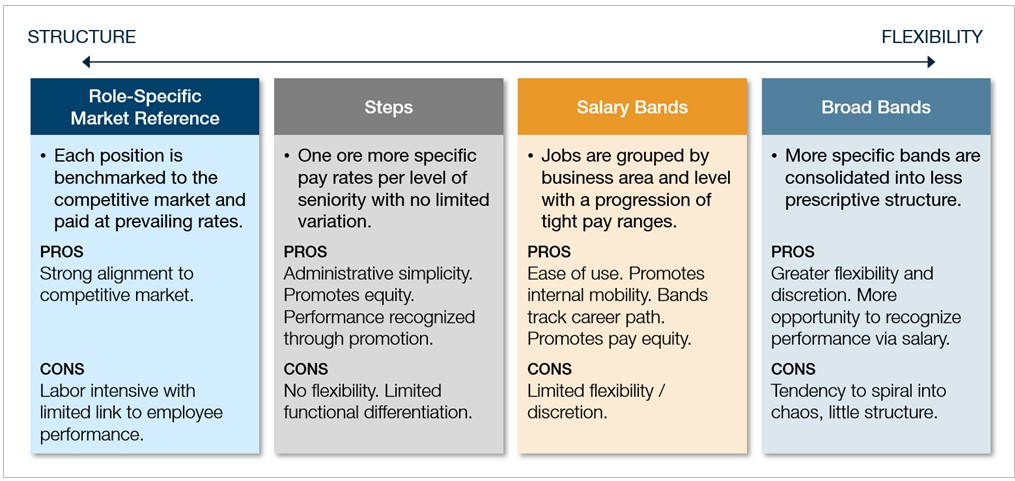
So much of the underpinning of pay equity relies on our ability to document what a role is, the associated responsibility/accountability, the expected annual objectives of the job, and how we measure performance.
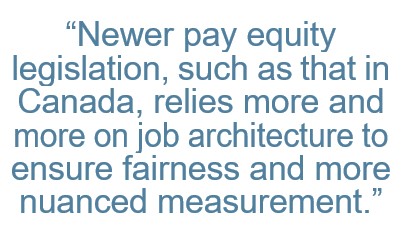
Newer pay equity legislation, for example such as that in Canada, relies more and more on job architecture to ensure fairness and more nuanced measurement:
- identify the different job classes made up of positions in their workplace
- determine whether each job class is predominantly male, predominantly female or gender neutral
- determine the value of work of each predominantly female or male job class
- calculate the compensation of each predominantly female or male job class, and
- compare the compensation between predominantly female and male job classes doing work of equal or comparable value
While much of how we measure pay equity tends to focus on salary, incentive pay is no less important of a topic, and is a critical component of both Pay and Career Equity. As in other practices, firms run the spectrum from completely discretionary bonuses to highly structured incentive opportunities based on role, seniority level, performance assessment, etc. Even with highly structured frameworks, there is often a reasonable opportunity to apply discretion, but again, these systems rely on a shared understanding of who is in what role, and at what seniority level. It is almost impossible to ensure pay equity (other than for commission or sales compensation) without solid Job Architecture as a foundation.
SUMMARY
In advancing Pay Equity from “a good to have” to a regulatory practice, organizations should broaden the strategy to address Career Equity. The five components of an equitable career – hiring equity, assessment equity, representation, advancement equity, and pay equity – can more realistically deliver on an equitable workplace where both employers and employees reap the benefits. Our belief is that Job Architecture, though not a panacea for all of the challenges ahead, is a critical building block for creating equitable workplaces of the future.

